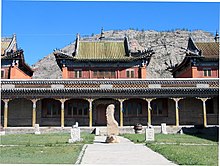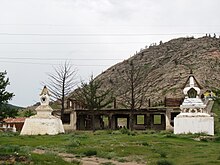Tsetserleg
|
Tsetserleg эцэрлэг |
||
| Country: |
|
|
| Aimag : | Archangai | |
| Coordinates: | 47 ° 29 ' N , 101 ° 27' E | |
| Height: | 1691 m | |
| Removal of UB | ||
| Beeline: | 410 km | |
| Driving distance: | 468 km | |
| Residents: | 18,519 (2000) | |
| Time zone: | UTC + 7 | |
|
|
||
Tsetserleg (also transliterated as Cėcerleg ; Mongolian Цэцэрлэг ) is the capital of the Arkhangai-Aimag (province) in Mongolia . It is located in the northeastern foothills of the Changai Mountains 1691 m. ü. M. not far from the Chorgo Terchiin Tsagaan Nuur National Park.
history
Tsetserleg is a historical center for culture and trade in the region. Historically there was a monastery, which was built by the first Chalch Zaja Pandita, Luwsanperenlei (1642-1715) (not to be confused with Zaya Pandita Namchaiiantsan (1599-1662)). The monastery consisted of the Right Temple, or Summer Semchin Temple, Guden Süm , and the Left Temple, or Winter Semchin Temple, both of which were built in the early 1680s. The sixth Zaja Pandita, Jambatseren, was killed by the communists in 1932 and the main temple was turned into a museum. Today's seventh Zaja Pandita lives in Ulaanbaatar and only visits the place occasionally.
economy
The main industry in the area is food processing.
Infrastructure
Tsetserleg has a theater, hotels, a hospital, numerous shops and an agricultural college.
traffic
Tsetserleg Airport (ZMTG / TSG) used to be served by regular flights to and from Ulaanbaatar. With the capital Ulaanbaatar and Kharkhorin Tsetserleg is connected by a paved road, travel on the buses.
Personalities
- Maidardschavyn Ganzorig (* 1949), scientist and former astronaut
Tourist sights
- The Zayain Gegeeni Süm monastery and temple complex used to be one of the largest monasteries in Mongolia. It was founded in 1586 and expanded in 1689, at times up to 1000 monks lived here. The monastery was largely spared from the anti-Buddhist riots and destruction under Chorloogiin Tschoibalsan in 1937, but the premises were and are used exclusively as a museum. After 1990, the facility was gradually renovated; the renovation work is currently (2011) not yet fully completed. This is where the Aimag Museum is located, one of the most worth seeing of its kind in Mongolia. Weapons, saddles, sacred objects and old musical instruments are exhibited. In the inner courtyard of the monastery there is a stele from the 6th century placed on a stone turtle, on which there are inscriptions in Sogdian , an extinct language. They are the oldest Buddhist inscriptions found in Mongolia.
- Next to the Zayain Gegeeni Süm monastery is the smaller Bujandelgerüülech Chiid monastery with a temple that is most frequently visited by the residents of Tsetsterleg. The religious ceremonies customary in Lamaism take place here regularly . Between the two above-mentioned monasteries, the ruins of another monastery building can be seen, which was destroyed in 1937.
- Above the monastery, on a slope of the rocky hill Bulgan Uul, the temple Galdan Dsuu is worth seeing, which was rebuilt after 1990. In front of the temple, from which there is an impressive view of the city of Tsetserleg and its surroundings, rises a seven meter high Buddha statue , completed in 2006 . Buddhist inscriptions that escaped destruction in 1937 can be found in the rock walls above the temple. Three large Buddha images were also carved into the rock. Since 1985 an area of 18 km² around the summit of Bulgan Uul (1980 m) has been under nature protection.
- In the north of the city, on the Gangin Gol River, along which hiking trails run, a natural history museum has been built, where stuffed animals can be seen.
Surroundings
The 773 km² Chorgo Terchiin Tsagaan Nuur National Park extends 150 km west of Tsetserleg . The park is named after the Terchiin Tsagaan Nuur lake , which is 16 km long, 4-6 km wide and up to 20 m deep. Its name means "White Lake", it is based on the fact that the lake is covered by ice until the end of May. Not far from the lake rises the extinct volcano Chorgo , around which an extensive lava surface with numerous caves, sparsely overgrown with larches and bushes, reminds of the last eruption 7,700 years ago. Until 1920 the chorgon was considered a holy mountain that only the selected were allowed to enter.
Climate table
| Tsetserleg | ||||||||||||||||||||||||||||||||||||||||||||||||
|---|---|---|---|---|---|---|---|---|---|---|---|---|---|---|---|---|---|---|---|---|---|---|---|---|---|---|---|---|---|---|---|---|---|---|---|---|---|---|---|---|---|---|---|---|---|---|---|---|
| Climate diagram | ||||||||||||||||||||||||||||||||||||||||||||||||
| ||||||||||||||||||||||||||||||||||||||||||||||||
|
Monthly average temperatures and rainfall for Tsetserleg
Source: wetterkontor.de
|
|||||||||||||||||||||||||||||||||||||||||||||||||||||||||||||||||||||||||||||||||||||||||||||||||||||||||||||||||||||||||||||||||||||||
Individual evidence
- ↑ The earth: Haack Small Atlas; VEB Hermann Haack geographical-cartographic institute, Gotha, 1982
- ↑ Michael Kohn: Mongolia. 5th edition. Lonely Planet, London 2008, ISBN 978-1-7410-4578-9 , p. 127.
- ^ Marion Wisotzki: Mongolia, traveling in the land of the nomads. Trescher, Berlin 2010, ISBN 978-3-89794-167-0 , p. 198.
- ↑ Michael Kohn: Mongolia. London 2008, p. 130.




